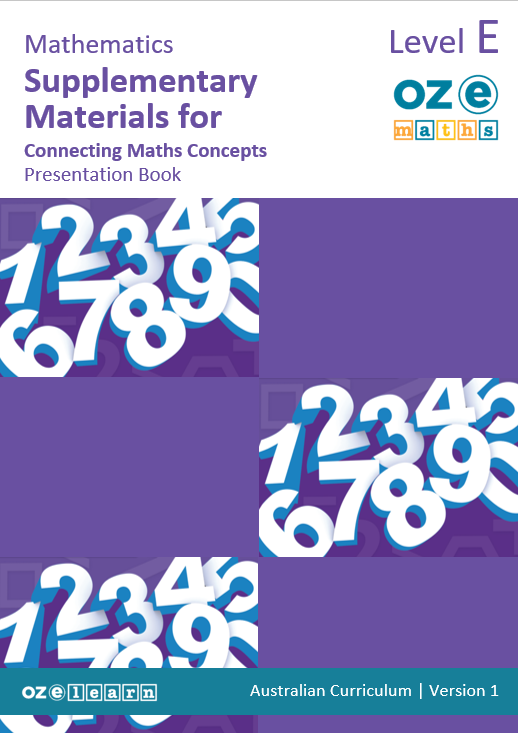Oz-e-maths Supplementary Materials for Connecting Maths Concepts Years F–5

In Lesson 10 (CMC Level E: Lesson 11-20), students learn to:
- define area
- identify regular shapes and calculate the area by counting the square centimetres
- write the area unit of measurement (cm2) for regular shapes
- identify irregular shapes and calculate the area by counting the square centimetres
- write the area unit of measurement (cm2) for irregular shapes.
In Lesson 11 (CMC Level E: Lesson 21-30), students learn to:
- identify odd and even numbers
- add with odd and even numbers
- subtract with odd and even numbers
- divide with odd and even numbers.
In Lesson 12 (CMC Level E: Lesson 31-40), students learn to:
- define data, identifying different methods for displaying data (table and frequency table) and how to interpret the data (tally marks)
- identify how a survey can be used to collect data and represented using a frequency table
- use tally marks to record and interpret data in a frequency table
- use a frequency table to record data collected from observation and surveys.
In Lesson 13 (CMC Level E: Lesson 41-50), students learn to:
- identify features of a picture graph
- construct a simple picture graph
- interpret a picture graph (picture represents frequency more than 1)
- construct a many-to-one picture graph
- identify features of a column graph
- identify features of the vertical (y) axis
- identify features of the horizontal (x) axis and compare graphs
- label the features and construct a column graph from given data
In Lesson 14 (CMC Level E: Lesson 51-60), students learn to:
- define data and how it can be displayed
- identify one-to-one correspondence in picture graphs
- identify many-to-one correspondence in picture graphs
- compare One-to-One and Many-to-One correspondence in picture graphs
- pose questions that can be answered by the data results
- compare different types of data displays with the same data represented in each
- compare different types of data displays and evaluate the effectiveness of each.
In Lesson 15 (CMC Level E: Lesson 61-70), students learn to:
- describe symmetry and examine symmetry in 2D shapes
- identify and draw lines of symmetry
- draw symmetrical shapes
- identify shapes with complex symmetry.
In Lesson 16 (CMC Level E: Lessons 91-100), students learn to:
- describe direction using the main points on a compass
- describe direction using the minor points on a compass
- describe direction of places on a map using points on a compass
- identify the compass points and use direction to describe and interpret information on a map
- use a legend to interpret information on a map
- construct a legend from the information contained in a map
- define and use scale to interpret distance on a map
- use scale to interpret approximate distances on a map
- construct a legend from information contained in a map, including a compass and scale
In Lesson 17 (CMC Level E: Lessons 101-110), students learn to:
- define: certain, likely, unlikely, impossible, and use these terms to describe the probability of events
- select either certain or impossible to describe the probability of an event
- select either likely or unlikely to describe the probability of an event
- order the probability of events from impossible to certain
- describe the probability of an event occurring as more likely, less likely, or equally likely
- order the probability of events from least likely to most likely.
In Lesson 18 (CMC Level E: Lessons 111-120), students learn to:
- define chance and apply the language of chance
- apply the language of chance to order from least to most likely
- apply the language of chance to order from least to most likely
- order from most likely, least likely and equal chance to occur
- define dependent events
- identify events that cannot happen at the same time
- define and label the timing of dependent events
- define and label when a dependent event affects another event
- identify when an event is dependent or not dependent.
In Lesson 19 (CMC Level E: Lessons 121-130), students learn to:
- identify independent events that can happen at the same time
- identify when an event is independent or dependent
- identify how independent events do not affect the next event
- identify independent and dependent events
- demonstrate understanding of the timing and effect of dependent and independent events

